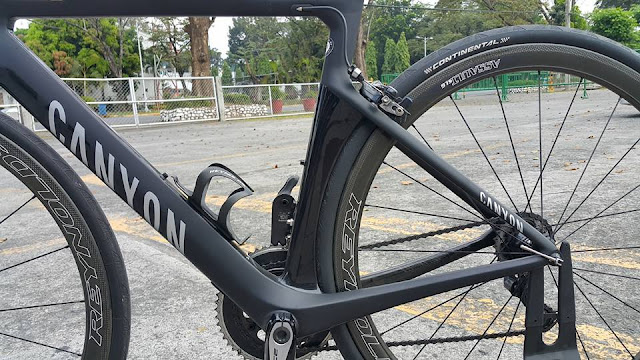One thing the Katusha mechanics changed in the bike setup were the tires. They used 28mm tires on the Aeroad.
Nearly every road cyclist now is aware of the advantages of using wider tires, of how rolling resistance and ride comfort are improved at the expense of gaining a few grams of weight. Manufacturers now are steadily pushing 25mm's over 23mm tires in their product lineups, even in budget setups.
Indeed, 25's are becoming mainstream. So how does the next step up perform compared to the new standard? The fact that someone shoehorned a 28mm tire on an Aeroad sent me scrambling to get one and try it out myself.
Is there really an advantage to riding on 28's?
Going through a roll call of local shops, the best I could find were some Continental 4 Seasons and some steel wired Kendas. Nothing against these, but these aren't the tires I was looking for.
To the internet I went and after a few days I had a pair of 28mm GP4000S2's on my work table. Everyone has their tire preference and this is mine. The GP4000's are a staple at the Roadiemanila stable (!).
Anyone who's worked with the GP4000 will be right at home with the tires. The all too familiar tread pattern, the directionality. All that's changed is the weight and girth of the thing. The 28mm Continentals weigh in 35 grams heavier than their 25mm brethren. Ours weighed in four grams below the manufacturer specs (this is always a good thing).
 |
| Weight Weenies wold shed tears at the ~35g weight gain over 25's |
Despite the extra width, mounting was uneventful. When inflated to 90psi, the 28mm Contis expand to 29.4mm as mounted on 25mm wide rims (Reynolds Assault SLG). Clearance is something you would definitely want to check before purchasing a tire of this size for your bike.
 |
| 29.4mm @ 90 psi |
I only mounted the 28 on the rear and transferred the previously installed 25mm to the front. This would place toughness on the rear tire while retaining steering agility up front. I also wanted to avoid the full weight penalty of a full 28mm setup (a potential ~70g).
The Ride
As we don't have scientific equipment to measure rolling resistance, we'll recount how our experience went with the wider tire.
I dropped the pressure to 85 psi and rode. I am quite familiar with how a 25mm tire feels at this pressure simply because this is my default.
Remember the feeling when you first swapped your 23mm tires to 25's? It's that exact same feeling all over again!
The 28's roll a bit better than the 25's at the same pressure. Again, the effect is similar to moving to 25's coming from 23's. More noticeable is the comfort provided by the wider tire. While you can still feel bumps as you roll over them, they are much more muted.
Weight? Although the 35 gram rolling weight penalty might sound like a lot, it only makes its presence felt at the scales. In-ride it was hardly noticeable... it did not matter that much in the hills.
As seen in the image below, mounting 28's on the Aeroad removed the wheel well gap behind the seatpost. While this looks good aesthetically, downside is when the tires pick up some sticky debris, there's a tendency for this to scratch the inner side of the seat tube. I managed to remove those scratches with some automotive wax. Owners will have to decide if this is a deal breaker in pursuing 28's.
 |
| Flush. |
Compared to thinner tires:
1. 28's have lower rolling resistance at similar pressures
2. More comfortable ride quality at similar pressures
3. Meatier tires are bit thicker and should last longer if made from similar compounds
The only downsides are:
1. Should be less aerodynamic due to the lightbulb effect - more so if mounted on <20mm rims
2. Weight
Ultimately, it's up to the individual cyclist to decide whether to go with the upsize or not. In my case, the advantages outweigh the cons. I'm happy with the switch and consider 28's a good upgrade.
!!!UPDATE April 2018!!!: I have reverted to 25mm tires. While the 28's clear the frame, this only holds true in perfect conditions. Riding on wet surfaces is a different matter as the tires tend to pick particles up, forcing them to rub the lower seattube. Damage was cosmetic and reverting to 25mm was done to prevent further deterioration. While everything said about 28mm tires holds true, factoring in debris should always be considered when checking for frame clearance.






No comments:
Post a Comment